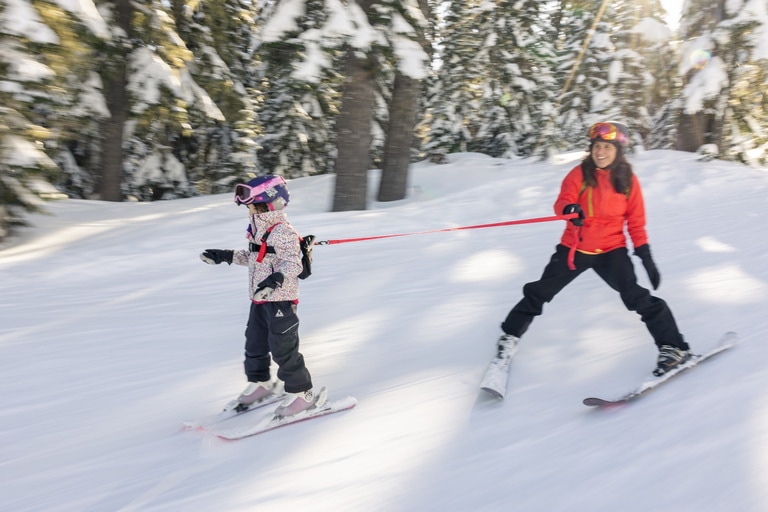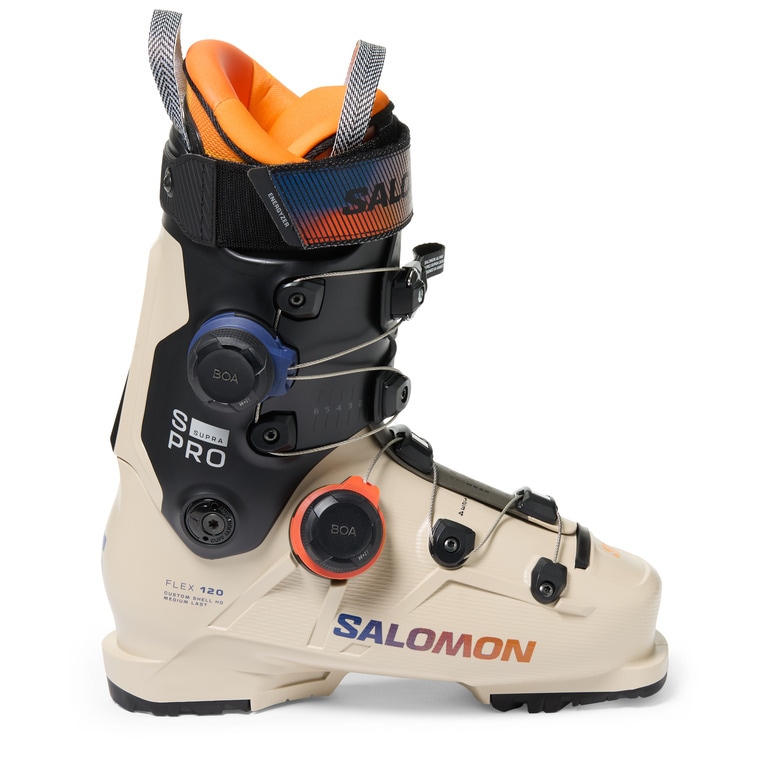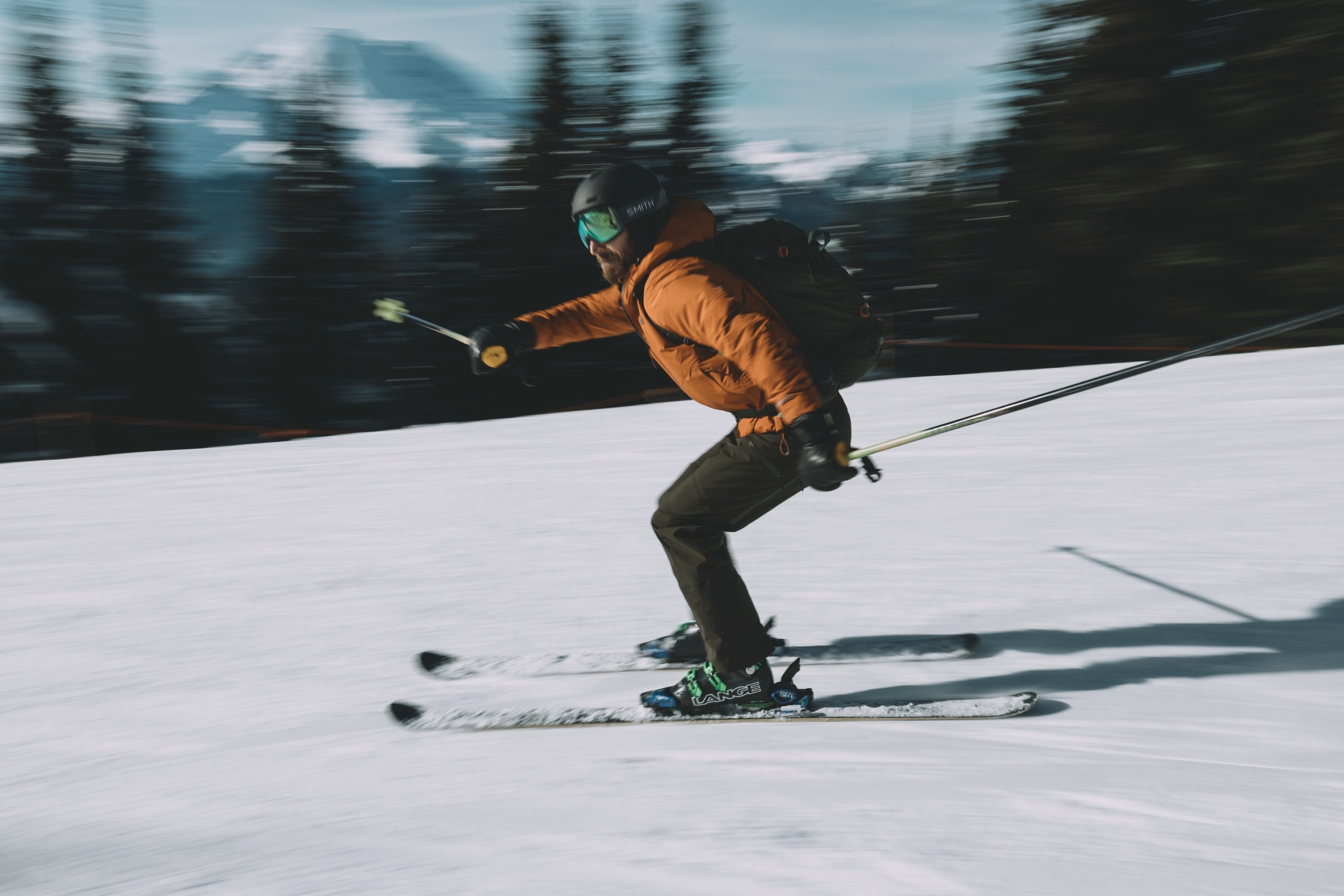Ski boots are arguably the most important piece of ski gear you’ll own. Find the right downhill ski boot for your foot shape and skiing style, and you’ll enjoy all-day comfort and performance you can feel. (On the flip side, wearing ill-fitting ski boots—or picking a pair that’s too stiff or too soft for your skill level or body type—can be a day-ender on the slopes.) In this guide, we’ll help you sort out what to look for when choosing the best downhill ski boots for you.
A ski boot should fit snugly and hold your foot securely in place, without causing pain or pressure points. It should feel like a firm handshake—not too tight, not too loose. Avoid buying boots that are too roomy just because they feel more comfortable when you first try them on; a snug and secure fit is critical to the boot’s performance.
Use the links below to jump to certain sections or read on to learn how to find your perfect ski boot.
Editor's Note: We updated this article on Oct. 13, 2025, to add more information about how to choose a boot, including a flex and volume chart, features to consider and ways to customize your boot for a dialed-in fit.
In-Store Boot Fitting
Your best chance of finding the right boot starts with an in-store fitting. Boot fitting experts at REI will look at the shape of your foot in person, measure your foot size, and help you try on a range of boots to find out what works best for you. So, consider this guide a useful tool for information before you visit an REI store. Our Ski Boot Sizing and Fit Guide can also help you determine the right size for you and what a properly fitting ski boot should feel like.
Video: Sizing Ski Boots
How to Size Ski Boots
Downhill ski boots use an international sizing standard called Mondopoint, which corresponds roughly to the length of your foot in centimeters. Ski boots are available in whole and half sizes, so you’ll see sizing options like 25, 25.5, 26 or 26.5. (Note: REI only carries half sizes. If you typically wear Mondopoint size 25, you’ll want to size up to 25.5). Keep in mind that sizing isn’t always universal across brands or even between models from the same brand. Be sure to consult the brand’s ski boot sizing chart for the best fit. Again, the best way to determine your correct Mondopoint size is by having your foot measured in person at a ski shop or REI store.
Here's a general ski boot size guide to get you started:
Chart: Mondopoint Ski Boot Sizes to US Sizes
Mondo | 21.5 | 22 | 22.5 | 23 | 23.5 | 24 | 24.5 | 25 | 25.5 | 26 |
|---|---|---|---|---|---|---|---|---|---|---|
Women's U.S. | 5 | 5.5 | 6 | 6.5 | 7 | 7.5 | 8 | 8.5 | 9 | 9.5 |
Men's U.S. | NA | NA | NA | 5 | 5.5 | 6 | 6.5 | 7 | 7.5 | 8 |
Mondo | 26.5 | 27 | 27.5 | 28 | 28.5 | 29 | 29.5 | 30 | 30.5 |
|---|---|---|---|---|---|---|---|---|---|
Women's U.S. | 10 | 10.5 | 11 | 11.5 | 12 | NA | NA | NA | NA |
Men's U.S. | 8.5 | 9 | 9.5 | 10 | 10.5 | 11 | 11.5 | 12 | 13 |
Understanding Boot Last
The width of the inside of the ski boot at the ball of your foot is called the “last.” Ski boot lasts, also known as widths, typically range from around 97mm to 106mm. Skiers with wider feet or those prioritizing comfort may opt for a boot with a wider last. Meanwhile, skiers with narrower feet or those seeking a tighter, high-performance fit will prefer a narrower last.
Foot Shape | Last Width | Volume |
|---|---|---|
Narrow | Under 100 millimeters | Low volume (LV) |
Average | 100-102 mm | Mid-volume or medium volume (MV) |
Wide | Over 102 mm | High volume (HV) |
Some boot manufacturers designate boot widths using terms like high volume, medium volume or low volume. Some brands may include those abbreviations—LV, MV or HV—in the model’s name.
If you have narrow feet, look for a low-volume boot. Examples include:
If you have wider feet, consider a high-volume boot. Examples include:
Match Your Boots to Your Style and Skill Level
Knowing your ski boot size and volume is just the beginning of finding the right fit. Next, you’ll want to figure out what style of ski boot matches your skiing ability and terrain preferences.
First, consider your ability: Are you a beginner just learning to ski, an intermediate skier tackling more challenging terrain or an expert hitting steeps? Your level of skiing will impact what type of boot you’ll want, what features to look for and what flex you need. (We’ll cover type, flex and features more below).
Next, think about what kind of skiing you normally do. Do you ski entirely inbounds at resorts? If so, do you prefer racing down groomed slopes or venturing into steeper, all-mountain terrain? Or are you a backcountry skier who needs a lightweight alpine touring boot built for long uphill climbs. Maybe you are looking for a hybrid touring boot that’s comfortable enough for uphill travel in the backcountry but is still powerful on the descent?
Types of Ski Boots
Different downhill skiers need different boots. If you’re spending most of your time inbounds at a ski resort, you’ll want a downhill ski boot that’s compatible with downhill ski bindings. On-piste skiers or ski racers may prefer a stiffer, race-style boot, while all-mountain resort skiers may want something with more freeride features, like shock absorption or a GripWalk sole.
If you’re skiing in the backcountry, you’ll want lightweight backcountry boots (also called alpine touring boots) that are built for mobility, with a walk mode for going uphill and a grippy sole. Some downhill ski boots are geared toward hybrid skiers who spend time inbounds and out of bounds, with both downhill performance and uphill capability. (Read more about How to Choose Backcountry Ski Boots.)
Telemark skiers will need a telemark boot that’s compatible with telemark ski bindings.
Several brands make downhill ski boots that are designed for women. These women-specific ski boots are generally shorter in the cuff to accommodate women’s leg shapes and have a softer flex. These models can suit anyone as long as they fit and feel good. (Not all unisex boots come in the smallest sizes, so a women-specific boot might be a good option for those with smaller feet.)
Young children should opt for kids’ downhill ski boots, designed specifically in kid sizes.

BOA is a relatively new technology in downhill ski boots. Instead of a traditional buckle, BOA uses a cable and dial system to offer micro-adjustability so you can fine-tune the fit. BOA ski boots tend to offer a more uniform, wrap-around feel over the foot, which can add comfort and convenience. We’ll explain more about BOA in the features section below.
Note: In this article, we've covered the ins and outs of downhill ski boots. If you want to learn about cross-country ski boots, read our article, How to Choose Cross Country Ski Gear.)
Ski Boot Flex: What the Ratings Mean
Ski boot manufacturers rate boots on a flex index: The higher the number, the stiffer the boot. The more rigid your boot, the more power you can transfer to your skis. When shopping for ski boots, the amount of flex the boots offer can roughly correlate to your ability level: beginner, intermediate or expert.
Your size and build can also determine what flex you need: Lighter or smaller skiers may prefer a lower flex rating to make it easier to drive the boot, while bigger or stronger skiers may want a higher flex, regardless of their ability.
Note: Flex ratings are also not universal across brands, so a 100-flex boot in one brand may feel different than a 100-flex boot from another manufacturer. Your best option is to try the boot on in store, press your shin toward the front of the boot by getting into an athletic stance and see how it feels.
Pro tip: The best way to compare boots when shopping is to put a boot on each foot, lean forward and flex them. Keep in mind that boots will have a softer flex in warm indoor environments than they will on a cold ski hill.
Typically, a softer flex like a 70 or 80 should feel very comfortable and forgiving; soft flex boots are best suited for smaller skiers or those who are new to the sport. A medium flex—somewhere in the 90 to 110 range—is generally geared toward intermediate to advanced skiers or skiers looking for increased responsiveness in a comfortable package. A stiff flex rating—over 110—is for stronger, expert-level skiers who prioritize performance and will be skiing with confidence on the most challenging terrain. So, a boot with a 130 flex, for example, is best suited for the most aggressive skiers out there.
Chart: Boot Flex and Skill Level
Skill Level | Ski Boot Flex | Flex Index Rating | Why |
Beginner | Women: Under 75 Men: Under 85
| Soft flex feels more comfortable, makes learning easier | |
Intermediate/Advanced | Women: 80-95 Men: 90-110
| Balances comfort with increased responsiveness | |
Expert | Women: Over 100 Men: Over 115
| Prioritizes performance and precision for the most confident skiers |
Key Ski Boot Features
Walk Mode
If you’re a backcountry skier or someone who likes to hike or bootpack inbounds to reach more terrain, look for boots with a walk mode. A lever on the back spine of the ski boot enables the boot’s shell to flex forward to give you a wider range of motion as you walk. This separates the upper shell from the lower boot for more comfortable movement. When you’re ready to ski down, flip the lever down to lock the upper and lower shell together to maximize power transmission.
Boot Liners
Most boots come with some amount of heat-moldable material in the liners to give you a custom fit. There are different styles of liners:
Non-moldable liners provide padding and stability for your feet right out of the box without any heat molding required, and over time, the sustained pressure of your body weight will cause the liner’s forefoot section to conform slightly to your foot shape. These liners are usually found in more entry-level boots.
Thermoformable liners use your foot’s heat to achieve a custom fit. They break in after a day or so of skiing.
Custom heat-moldable liners use an artificial heat source to achieve the highest level of customized fit. This is best done at REI or other ski shops with boot fitting expertise. These liners are usually found in more premium, high-performance boots.
Buckles versus BOA

As we mentioned above, BOA is a technology that adds a multi-directional dial and cable-and-pulley system in lieu of a standard metal buckle. This can impact fit and convenience. Turn the knob to tighten a cable through a set of plastic pulleys for a more customized fit than two buckles on the lower shell. Boots with BOA dials tend to have a more even and wrapped feel around the foot than buckles can provide. The dial allows you to make tiny adjustments, so the boot feels slightly roomier or snugger for a just-right fit. BOA boots can be a bit heavier and more expensive, but the trade-off is higher comfort and ease of use.
In 2023, ski boot manufacturers like K2, Salomon, Atomic and Fischer began introducing the BOA dial into the bottom shell of ski boots. (Read more about the BOA ski boots.) In the 2025/26 season, boot brands like Salomon have added two BOA dials—one on the upper cuff and one on the lower shell.
Customizing Your Ski Boots
The way a boot feels out of the box when you first try it on is a good starting point. But you can customize your ski boots further for an even better fit.
Your options to customize your boots include:
Expanding or shrinking the boot shell
Heat-molding the boot liners
Adjusting forward lean, canting or flex
Repositioning the tongue
Adding aftermarket or custom insoles or footbeds.
Simpler adjustments like repositioning the tongue and adding custom insoles can be made at home. Others, like modifying the shell, are best performed by an expert in-store boot fitter. For more information, read out in-depth article on How to Size and Fit Your Skis Boots.
Why Trust This Guide
To compile this resource on downhill ski boots, we interviewed ski experts both inside REI and outside. Our experts have written about skiing for major publications, provided gear recommendations to outdoor enthusiasts and helped hundreds find the right boot fit.
Meet the experts
Megan Michelson, a Tahoe-based freelance journalist and longtime REI contributor, learned to ski when she was 2. A former editor at Skiing Magazine, she has been testing and writing about ski gear for going on two decades now.
Miguel Castro, a shop service manager at the REI store in Laguna Hills, California, has been a ski boot fitter for over a decade. With more than six years of boot fitting experience across three REI locations, he has helped over 1,200 skiers and snowboarders find their perfect boot fit. He’s also worked with wounded veterans who require specialized customization. Miguel has completed two years of training with MasterFit University, a leading program for snowsports boot fitters. Among the courses, he completed an advanced boot customization class focused on medical and special-case fittings.
Andrew White, an REI merchandising replenishment analyst for snowsports, has worked as a ski boot fitter at the Denver REI store for 16 years. He’s been an REI employee since 1999.
Matt Manser, ski boot product manager for Atomic, is a former boot fitter who knows the ins and outs of ski boots perhaps better than anyone. He’s based in Austria.


